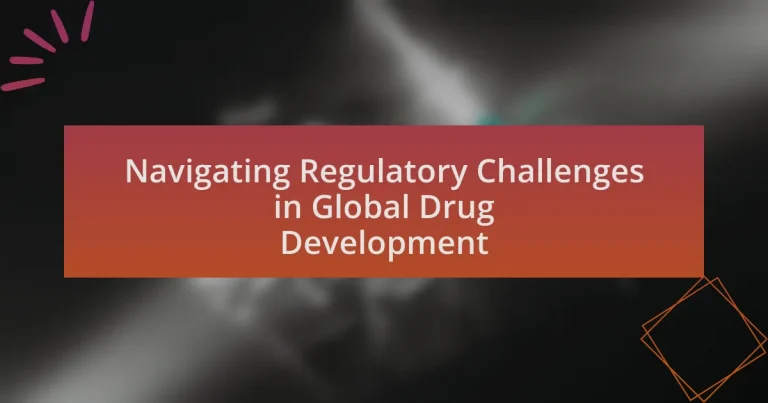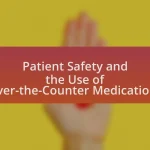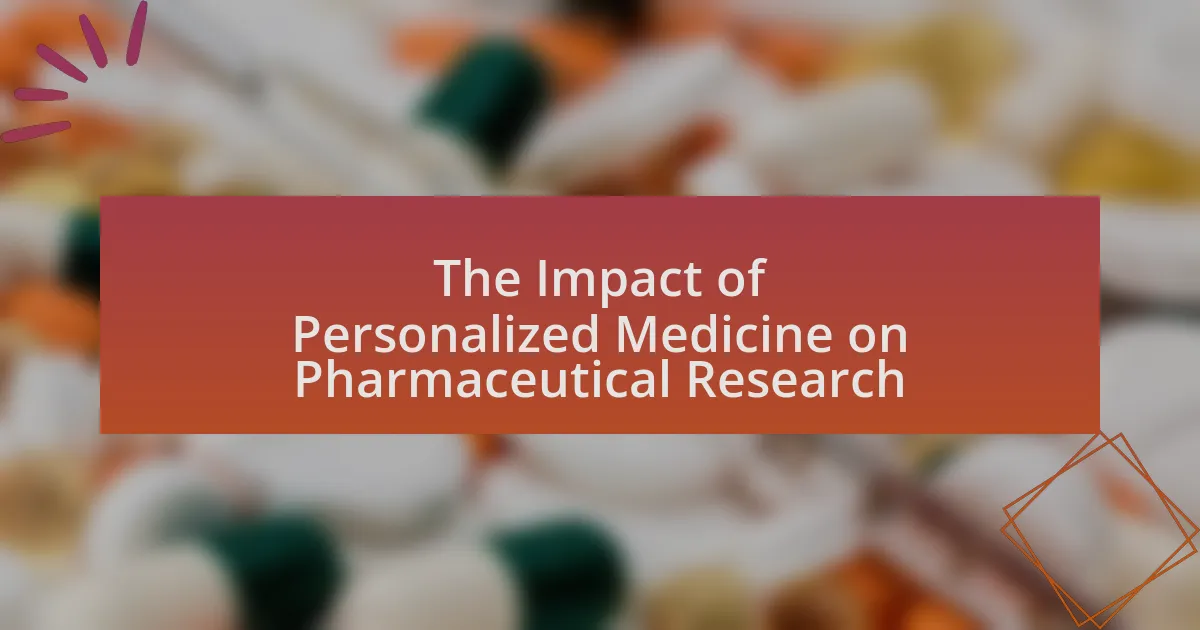The article focuses on the regulatory challenges faced in global drug development, highlighting the complexities arising from varying requirements across countries, lengthy approval processes, and compliance with diverse safety and efficacy standards. It examines the differences in regulatory frameworks, the roles of major regulatory bodies such as the FDA and EMA, and the importance of understanding local regulations for successful drug approval. Additionally, the article discusses strategies for navigating these challenges, including proactive engagement with regulatory agencies, leveraging regulatory intelligence, and the impact of technology on compliance and efficiency. Emerging trends in drug regulation, such as increased collaboration among agencies and the integration of digital health technologies, are also explored, emphasizing the need for drug developers to stay informed and adaptable in a rapidly evolving landscape.
What are the key regulatory challenges in global drug development?
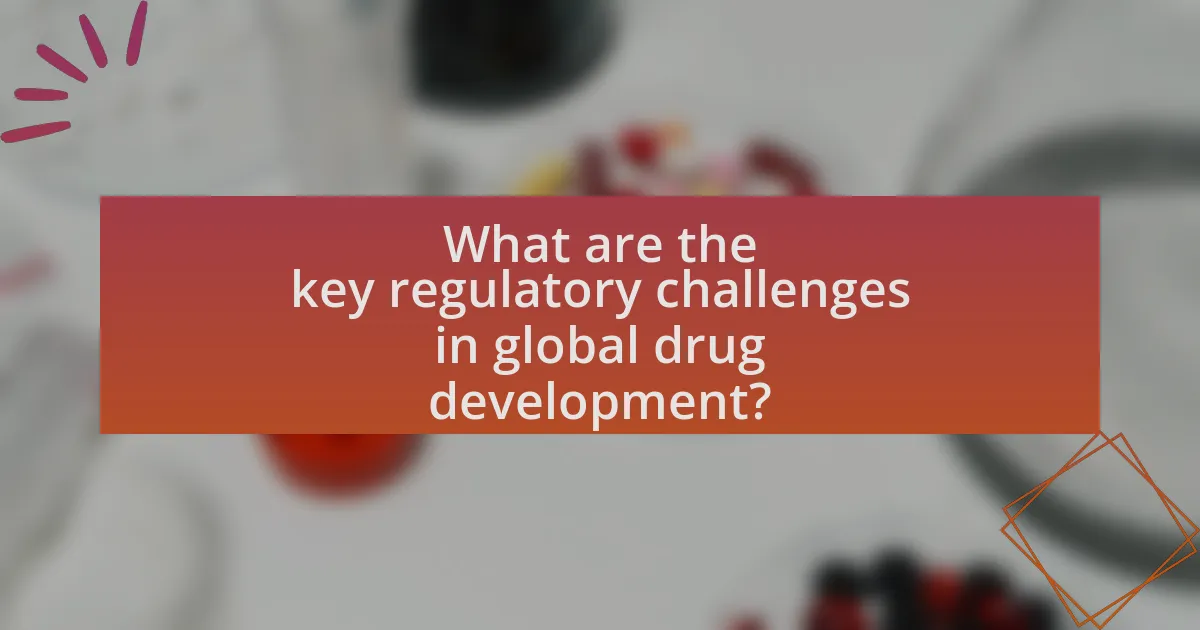
The key regulatory challenges in global drug development include varying regulatory requirements across countries, lengthy approval processes, and the need for compliance with diverse safety and efficacy standards. Different countries have distinct regulations, which complicates the development and approval of drugs intended for multiple markets. For instance, the U.S. Food and Drug Administration (FDA) and the European Medicines Agency (EMA) have different guidelines, leading to potential delays and increased costs for pharmaceutical companies. Additionally, the approval process can take several years, during which time regulations may change, further complicating compliance. These challenges necessitate strategic planning and adaptability from drug developers to navigate the complex global landscape effectively.
How do regulatory frameworks differ across countries?
Regulatory frameworks differ across countries primarily in their structure, requirements, and enforcement mechanisms. For instance, the United States operates under the Food and Drug Administration (FDA), which emphasizes a rigorous pre-market approval process, while the European Union utilizes the European Medicines Agency (EMA), which allows for centralized marketing authorizations. Additionally, countries like Japan have unique regulations that incorporate local clinical trial data, reflecting cultural and healthcare system differences. These variations impact timelines, costs, and strategies for drug development, as evidenced by the differing approval times for new drugs; the FDA’s average approval time is around 10 months, whereas the EMA’s can take up to 15 months.
What are the major regulatory bodies involved in drug development?
The major regulatory bodies involved in drug development are the U.S. Food and Drug Administration (FDA), the European Medicines Agency (EMA), and the World Health Organization (WHO). The FDA oversees the approval and regulation of drugs in the United States, ensuring safety and efficacy through rigorous clinical trials and review processes. The EMA serves a similar function in the European Union, facilitating the centralized approval of medicines across member states. The WHO provides international guidelines and standards for drug development, promoting global health and safety. These organizations play critical roles in establishing regulations that govern the drug development process, ensuring that new medications meet necessary safety and efficacy standards before reaching the market.
How do these bodies influence the drug approval process?
Regulatory bodies influence the drug approval process by establishing guidelines and standards that pharmaceutical companies must follow to ensure safety and efficacy. These organizations, such as the U.S. Food and Drug Administration (FDA) and the European Medicines Agency (EMA), review clinical trial data, assess manufacturing practices, and evaluate labeling to determine whether a drug can be marketed. Their decisions are based on rigorous scientific evaluation and public health considerations, which are critical for maintaining drug quality and protecting patient safety. For instance, the FDA requires a New Drug Application (NDA) that includes comprehensive data from clinical trials, demonstrating that the benefits of the drug outweigh its risks before granting approval.
Why is understanding local regulations crucial for drug developers?
Understanding local regulations is crucial for drug developers because compliance with these regulations ensures the safety, efficacy, and legal approval of new drugs. Each country has specific regulatory frameworks that dictate the requirements for clinical trials, manufacturing practices, and marketing authorization. For instance, the U.S. Food and Drug Administration (FDA) and the European Medicines Agency (EMA) have distinct guidelines that must be followed to gain market access. Failure to adhere to local regulations can lead to delays in drug approval, financial penalties, or even the rejection of a drug application, as evidenced by the fact that non-compliance can result in a 30% increase in time to market for pharmaceutical products. Therefore, understanding and navigating these regulations is essential for successful drug development and commercialization.
What are the consequences of non-compliance with local regulations?
Non-compliance with local regulations can lead to severe legal and financial consequences for organizations involved in drug development. These consequences may include hefty fines, legal action, and potential criminal charges against responsible individuals. For instance, the U.S. Food and Drug Administration (FDA) can impose fines that reach millions of dollars for violations, and companies may face lawsuits from affected parties. Additionally, non-compliance can result in the suspension or revocation of licenses necessary for drug development and distribution, severely impacting a company’s ability to operate. Furthermore, reputational damage can occur, leading to loss of trust from stakeholders, investors, and the public, which can hinder future business opportunities and collaborations.
How can developers stay updated on regulatory changes?
Developers can stay updated on regulatory changes by subscribing to industry newsletters, attending relevant conferences, and participating in professional organizations. These methods provide timely information and insights directly from regulatory bodies and industry experts. For instance, organizations like the Regulatory Affairs Professionals Society (RAPS) offer resources and updates on regulatory developments, while conferences such as the DIA Global Annual Meeting facilitate networking and knowledge sharing among professionals. Additionally, following regulatory agencies’ official websites and social media channels ensures access to the latest announcements and guidelines.
What strategies can be employed to navigate regulatory challenges?
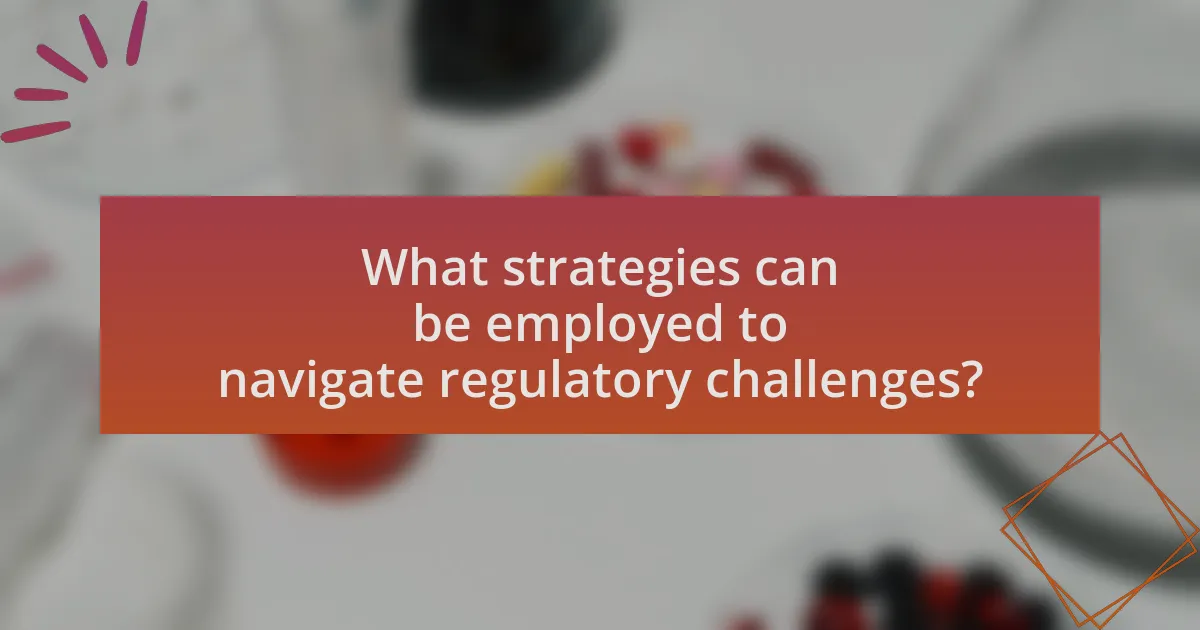
To navigate regulatory challenges in global drug development, organizations can employ strategies such as proactive engagement with regulatory authorities, thorough understanding of local regulations, and implementation of robust compliance frameworks. Proactive engagement involves establishing open lines of communication with regulators to clarify expectations and address concerns early in the development process. Understanding local regulations is crucial, as different countries have varying requirements that can impact timelines and approval processes. Implementing compliance frameworks ensures that all aspects of drug development adhere to regulatory standards, thereby minimizing the risk of delays or rejections. These strategies are supported by the fact that companies that maintain strong relationships with regulators often experience smoother approval processes, as evidenced by studies showing that early dialogue can lead to more efficient regulatory pathways.
How can collaboration with regulatory agencies facilitate drug development?
Collaboration with regulatory agencies can facilitate drug development by streamlining the approval process and ensuring compliance with safety and efficacy standards. Engaging with these agencies early in the development process allows pharmaceutical companies to gain insights into regulatory requirements, which can lead to more efficient study designs and faster submission of clinical trial applications. For instance, the FDA’s Breakthrough Therapy designation provides expedited development and review for drugs that treat serious conditions and fill an unmet medical need, demonstrating how regulatory collaboration can significantly reduce time to market.
What are the benefits of early engagement with regulators?
Early engagement with regulators facilitates smoother drug development processes. By initiating discussions early, companies can gain insights into regulatory expectations, which helps in aligning their development strategies with compliance requirements. This proactive approach can lead to reduced timeframes for approvals, as early feedback allows for adjustments to be made before formal submissions. Additionally, early engagement can foster stronger relationships with regulatory bodies, enhancing communication and trust, which can be beneficial during the review process.
How can developers leverage feedback from regulatory agencies?
Developers can leverage feedback from regulatory agencies by integrating the insights into their drug development processes to enhance compliance and improve product safety. This feedback often includes guidance on clinical trial design, data requirements, and safety protocols, which can help developers align their projects with regulatory expectations. For instance, the U.S. Food and Drug Administration (FDA) provides detailed recommendations through documents like the “Guidance for Industry,” which outlines best practices and regulatory standards. By actively engaging with these resources, developers can reduce the risk of delays in approval and ensure that their products meet the necessary safety and efficacy standards.
What role does regulatory intelligence play in drug development?
Regulatory intelligence plays a crucial role in drug development by providing insights into regulatory requirements and trends that influence the approval process. This intelligence helps pharmaceutical companies anticipate changes in regulations, understand the expectations of regulatory agencies, and streamline their development strategies to ensure compliance. For instance, a study published in the Journal of Pharmaceutical Sciences highlighted that companies utilizing regulatory intelligence effectively reduced time to market by 20% compared to those that did not. By leveraging regulatory intelligence, organizations can make informed decisions, mitigate risks, and enhance the likelihood of successful drug approvals.
How can developers utilize regulatory intelligence tools effectively?
Developers can utilize regulatory intelligence tools effectively by integrating them into their drug development processes to ensure compliance with global regulations. These tools provide real-time access to regulatory updates, guidance documents, and submission requirements, enabling developers to stay informed about changes that may impact their projects. For instance, using platforms like Regulatory Affairs Professionals Society (RAPS) or Global Regulatory Affairs (GRA) can streamline the tracking of regulatory changes across different regions, which is crucial for timely submissions and approvals. By leveraging data analytics features within these tools, developers can also identify trends and anticipate regulatory challenges, thereby enhancing their strategic planning and decision-making processes.
What are the best practices for gathering regulatory intelligence?
The best practices for gathering regulatory intelligence include establishing a systematic approach to monitor regulatory changes, utilizing technology for data collection and analysis, and engaging with regulatory experts. A systematic approach ensures that organizations stay updated on relevant regulations and guidelines, which is crucial in the dynamic field of drug development. Technology, such as regulatory intelligence platforms, can streamline the collection of data from various sources, making it easier to analyze trends and changes. Engaging with regulatory experts provides insights that may not be readily available through public sources, enhancing the understanding of complex regulatory landscapes. These practices are supported by the increasing reliance on data-driven decision-making in the pharmaceutical industry, as evidenced by the growing adoption of regulatory intelligence tools among leading companies.
What are the emerging trends in global drug regulation?
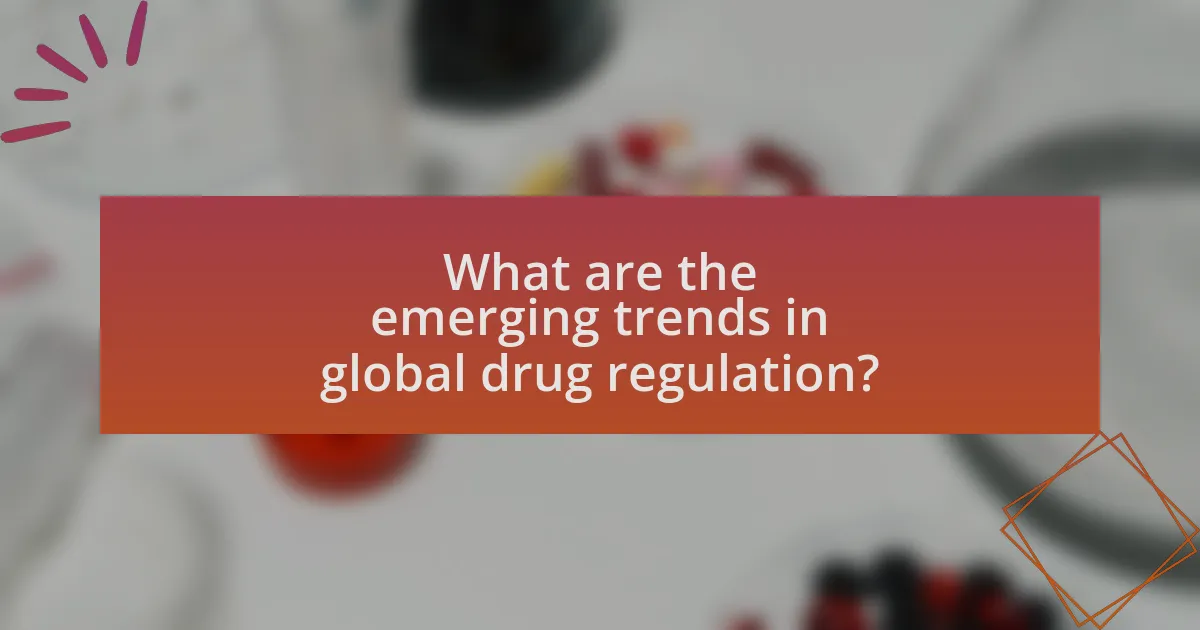
Emerging trends in global drug regulation include increased collaboration among regulatory agencies, the adoption of digital health technologies, and a focus on patient-centric approaches. Regulatory agencies, such as the FDA and EMA, are enhancing partnerships to streamline approval processes and share data, which improves efficiency and safety. The integration of digital health technologies, including telemedicine and electronic health records, is transforming how drug efficacy and safety are monitored post-approval. Additionally, there is a growing emphasis on involving patients in the drug development process, ensuring that their needs and experiences shape regulatory decisions. These trends reflect a shift towards more agile, transparent, and responsive regulatory frameworks that adapt to the evolving landscape of drug development.
How is technology impacting regulatory processes?
Technology is significantly enhancing regulatory processes by streamlining data collection, improving transparency, and facilitating real-time monitoring. For instance, the use of electronic submissions and digital platforms allows regulatory agencies to process applications more efficiently, reducing the time required for approvals. Additionally, technologies such as artificial intelligence and machine learning are being employed to analyze vast amounts of data, enabling regulators to identify potential safety issues and trends more quickly. According to a report by the FDA, the implementation of digital tools has led to a 30% reduction in the average review time for new drug applications, demonstrating the tangible benefits of technology in regulatory frameworks.
What innovations are being adopted in regulatory submissions?
Innovations being adopted in regulatory submissions include the use of digital technologies, such as electronic submissions and data analytics, to streamline the process. Regulatory agencies are increasingly implementing electronic Common Technical Document (eCTD) formats, which enhance the efficiency and accuracy of submissions. Additionally, artificial intelligence and machine learning are being utilized to analyze large datasets, predict outcomes, and identify potential regulatory issues early in the development process. These innovations aim to reduce submission timelines and improve the overall quality of the data provided to regulatory authorities.
How can artificial intelligence improve compliance and efficiency?
Artificial intelligence can improve compliance and efficiency in global drug development by automating regulatory processes and enhancing data analysis. AI systems can analyze vast amounts of regulatory data to identify compliance risks and streamline documentation, reducing the time and effort required for submissions. For instance, AI algorithms can predict potential regulatory hurdles by analyzing historical data from previous drug approvals, which can lead to more informed decision-making. Additionally, AI-driven tools can monitor ongoing clinical trials in real-time, ensuring adherence to regulatory standards and facilitating quicker adjustments when necessary. This capability not only enhances compliance but also accelerates the overall drug development timeline, ultimately leading to faster market access for new therapies.
What are the implications of globalization on drug regulation?
Globalization significantly impacts drug regulation by creating a complex landscape where regulatory standards and practices vary across countries. This variation can lead to challenges in ensuring drug safety and efficacy, as multinational pharmaceutical companies must navigate different regulatory requirements in each market. For instance, the World Health Organization emphasizes the need for harmonization of regulatory standards to facilitate international trade and ensure public health safety. Additionally, globalization can result in increased access to medicines, but it also raises concerns about the potential for substandard or counterfeit drugs entering markets due to less stringent regulations in some regions.
How do international agreements affect local regulatory practices?
International agreements significantly influence local regulatory practices by establishing common standards and frameworks that countries adopt to facilitate trade and cooperation. These agreements, such as the World Trade Organization’s Trade-Related Aspects of Intellectual Property Rights (TRIPS), require member states to align their national laws with international norms, thereby harmonizing regulations across borders. For instance, TRIPS mandates that countries provide patent protection for pharmaceuticals, which impacts local drug approval processes and market access. This alignment can lead to increased efficiency in regulatory practices, as local authorities often rely on international guidelines to streamline their procedures and ensure compliance with global expectations.
What challenges arise from harmonizing regulations across borders?
Harmonizing regulations across borders presents significant challenges, including differing legal frameworks, cultural attitudes towards regulation, and varying levels of regulatory capacity among countries. These differences can lead to inconsistencies in compliance requirements, making it difficult for companies to navigate multiple regulatory environments. For instance, the European Union and the United States have distinct regulatory processes for drug approval, which can complicate international clinical trials and market entry strategies. Additionally, disparities in scientific standards and data requirements can hinder collaboration and increase the time and cost associated with drug development.
What practical tips can help drug developers navigate regulatory challenges?
Drug developers can navigate regulatory challenges by establishing early and continuous communication with regulatory agencies. Engaging with agencies like the FDA or EMA during the drug development process allows developers to clarify requirements, receive feedback on study designs, and address potential issues proactively. This approach is supported by the FDA’s guidance on the importance of pre-IND meetings, which facilitate dialogue and help align development plans with regulatory expectations. Additionally, maintaining thorough documentation and understanding the specific regulations in target markets can further streamline the approval process, as evidenced by successful case studies where companies that adhered to these practices experienced faster approvals.
How can effective communication with stakeholders enhance compliance?
Effective communication with stakeholders enhances compliance by ensuring that all parties understand regulatory requirements and expectations. Clear dialogue fosters transparency, allowing stakeholders to voice concerns and seek clarification, which reduces the likelihood of misunderstandings that can lead to non-compliance. For instance, studies have shown that organizations with robust communication strategies experience up to 30% fewer compliance violations, as stakeholders are more informed and engaged in the compliance process. This proactive approach not only aligns stakeholder actions with regulatory standards but also builds a culture of accountability and trust, further reinforcing compliance efforts.
What resources are available for ongoing regulatory education?
Ongoing regulatory education resources include professional organizations, online courses, webinars, and industry conferences. Organizations such as the Regulatory Affairs Professionals Society (RAPS) offer certifications and training programs that focus on regulatory practices in drug development. Online platforms like Coursera and edX provide courses on regulatory affairs, often developed in collaboration with universities and industry experts. Webinars hosted by regulatory agencies, such as the FDA and EMA, deliver updates on new regulations and guidance. Additionally, industry conferences, such as the DIA Global Annual Meeting, facilitate networking and knowledge sharing among professionals in the field. These resources collectively enhance understanding and compliance with evolving regulatory requirements in global drug development.
